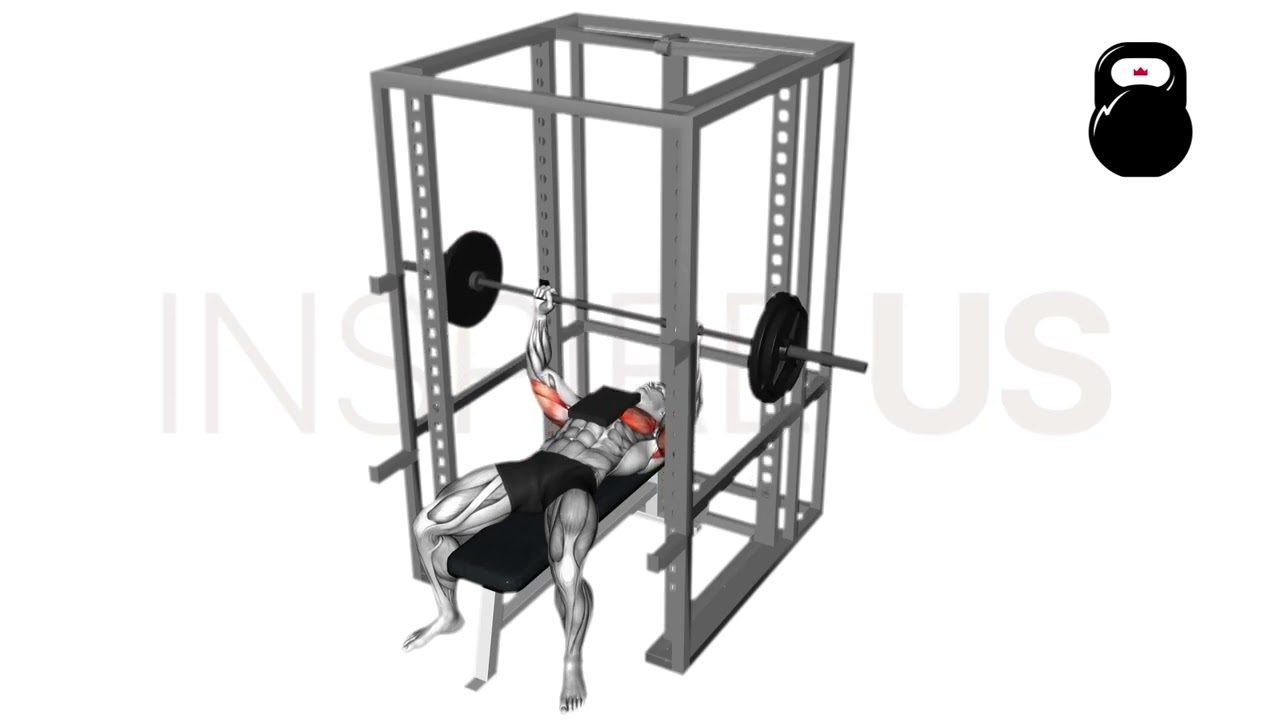Board Bench Press: Benefits, Muscles Worked, and More
Whether you’re a powerlifter wishing to perfect your bench press execution or just want to isolate specific muscle groups - the board bench press is an invaluable tool.
In essence, the board bench press is simply a conventional barbell bench press performed with a block or board placed atop the chest of the lifter. This arrests the bar’s movement before it reaches their chest, forcing the lifter to only perform a short section of the exercise’s ROM alongside a few other advantages.
Follow along as we explore how to perform the board bench press, what specific height of board you should be using and the many benefits this exercise can offer.
What is the Board Bench Press?
The board bench press is identical in classification to the conventional bench press.
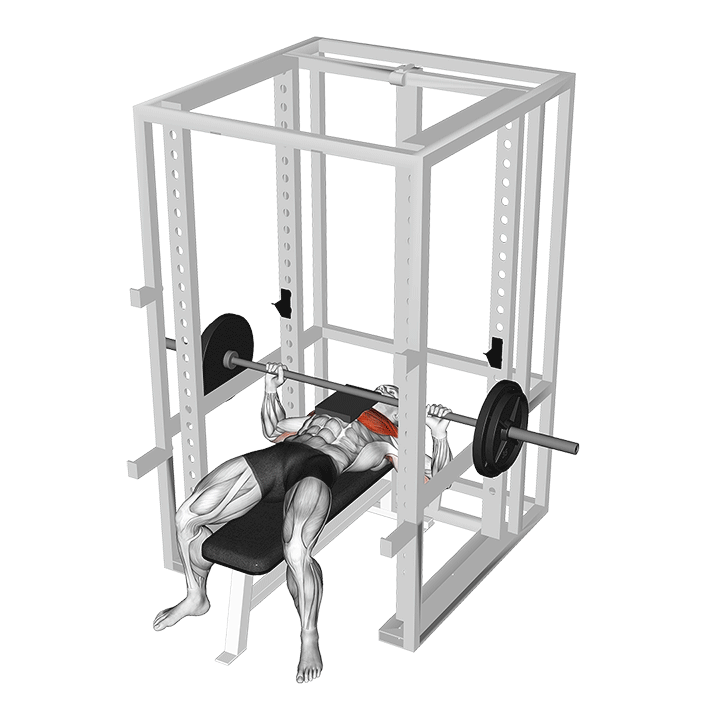
This means it is an open chain compound movement primarily involving elbow flexion/extension, scapular retraction and minor levels of shoulder rotation.
The board bench press is most commonly performed by competitive strength athletes wishing to improve a certain aspect of their conventional bench press execution. This could be the correction of sticking points, poor explosiveness, diagnosis of form issues or weakness in certain muscle groups.
However, the board bench press is also performed so as to better isolate certain muscles while still performing a bench press. Depending on the specific height of the boards used, the triceps or deltoids may be isolated to a greater degree.
Should You Do the Board Bench Press?
The board bench press is a highly specific and technical variation of chest press.
This means that it is largely unsuitable for novices, as an already pre-established level of technical familiarity and strength will be needed to benefit from it.
Powerlifters, other types of strength athletes or intermediate and advanced lifters are the audience that will see the most improvement from performing the board bench press.
Selecting the Right Board Height/Number
Generally, a board will be approximately 1-2 inches in thickness - although many DIY boards are simply repurposed wooden planks or similar materials. It is best to measure out the boards you plan to use if specificity is your goal.

For correcting sticking points or weaknesses in conventional bench press execution, the board height should be set to just below the issue in your range of motion.
This means if you suffer from poor drive just after the touchpoint, aim for a board height that is only an inch or two off your chest, or what is known as a “1 board” bench press.
Alternatively, if you wish to better isolate your triceps, aiming for 2-4 inches off the chest or a “2/3 board” bench is far preferable.
Issues with lockout may be more difficult to correct with the use of boards, but can be attempted with more than 3 boards. Have a training partner secure the boards to your chest - or try out the pin press as an alternative exercise.
How to Do the Board Bench Press
Performing the board bench press is quite similar to a regular bench press, only with a different range of motion.
To do so, the lifter must first select the correct elevation for their boards. We’ve covered this in the previous section.
Setting the boards securely on their chest as they lie beneath the bar, the lifter will then place their hands approximately shoulder-width apart along the bar and unrack it. The shoulder blades should be fully retracted, the glutes pressed into the bench and the lower back arched.
With the arms fully extended over the torso, the lifter then engages their chest and bends at the elbows. This should slowly lower the bar towards the boards, where the lifter will work to arrest the bar’s momentum and bring it to a full stop atop the boards.
Once the bar is completely immobile atop the board, the lifter rapidly drives through their heels, squeezes their chest once more and contracts their triceps brachii - pushing the bar upwards until it has returned to the lockout point.
At this point, the repetition is considered complete.
What Muscles are Worked by the Board Bench Press?
The board bench press is what is known as a compound movement, meaning that multiple muscles are involved in its movement pattern. Depending on the height of the boards being used, the specific involvement of these muscles will vary.
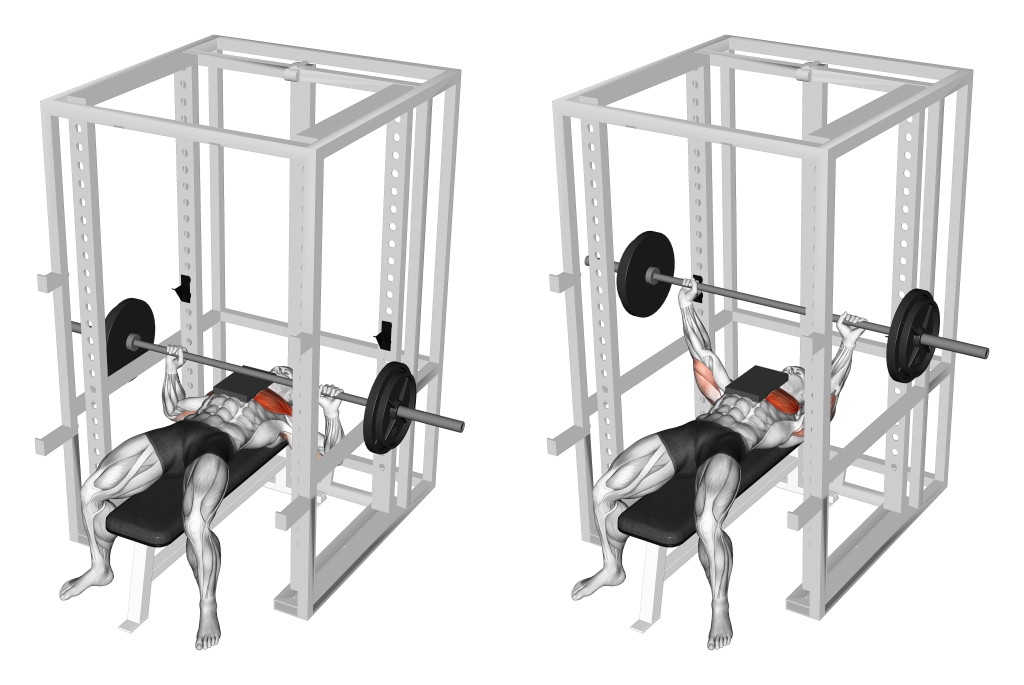
If contracted dynamically, the muscles are referred to as “mobilizer” or “mover” muscles, whereas if contracted isometrically, they are called “stabilizer” muscles.
Mobilizer Muscles
The board bench press will dynamically target the triceps brachii and deltoids, regardless of board height.
However, the involvement of the pectoral muscles will become less and less dynamic the higher the bar is stopped. This means that the chest may become a stabilizer muscle after a certain elevation.
Generally, if the bar stops mid-path, the anterior deltoids are emphasized. Near the top half of the path, the triceps are the central muscle. Near the bottom range, the chest.
Stabilizer Muscles
Apart from the aforementioned mobilizer muscles, the medial and posterior deltoids alongside the serratus and the trapezius are all used regardless of board height.
Of course, the length in which these muscles are contracted will depend on the range of motion and tempo of the exercise itself. While these muscles are contracted regardless of where the bar stops, the extent of their development from the board press will indeed vary.
What are the Benefits of Doing the Bench Press With a Board?
The board bench press offers quite a few situational benefits when performed correctly - some of which we’ve mentioned previously.
Corrects Sticking Points
The main benefit and reason behind performing the board press is to correct sticking points.
Whether it be due to weak triceps strength in the lockout range, poor explosiveness after the bar leaves the chest or loss of drive in the midrange, the board bench press can fix it.
Of course, in order to do so, it is important to ensure that the bar comes to a rest at a point at or just beneath the sticking point itself. This can be further supplemented by performing further bench press specific exercises that target any weak muscles or ranges that may be present.
For example, if poor lockout is present, performing triceps-focused pressing movements like the close grip bench press or diamond push-ups can help alleviate the sticking point.
Improves Bench Press Explosiveness and Power
Even if no sticking point is present within the lifter’s bench press technique, poor explosiveness or power may still be a limiting factor in their performance.
Poor explosiveness and power can appear as if the bar is moving too slowly through the concentric portion of the movement - or if the sensation of “grinding” through the repetition is present, even during low-volume working weight sets.
Because the board bench press forces the lifter to bring the bar to a stop before it actually touches their chest, they can learn to better utilize their strength in a rapid manner, especially in regards to the triceps and deltoids.
For even greater development of upper body explosiveness, try performing the push press or the pause bench press.
Allows for Greater Isolation of Specific Muscles
Although the board bench press is by no means an isolation exercise, lifters can use it to further isolate specific muscle groups that may be eclipsed by their pecs during regular bench press performance.
To do so, the lifter can either choose to isolate their deltoids by arresting the bar mid-way through its regular path, or to isolate the triceps more by aiming for the upper half of the range.
Of course, this is all meant to be done within the specific context of bench press technique improvement. If isolating certain muscles is truly what the lifter is after, they will be far better served with actual isolation exercises like the triceps pushdown or lateral raises.
Allows for Greater Bench Press Volume With Less Fatigue Limitations
Because completing a full range of movement is more fatiguing than only a partial one, the board bench press can be used in a similar manner to half squats for increasing total training volume.
That is to say - once several sets of conventional bench press have already been completed, the lifter can further “squeeze out” training stimulus by employing the comparatively less taxing board bench press after.
Aids in Building Lifter’s Confidence With Heavy Loads
Occasionally, an athlete may be capable of performing a significantly intense task but lack the confidence to actually try. This is especially prevalent among strength athletes where the risk of failure and injury can be significant.
Fortunately, it is possible to use the board bench press as a soft-demo of a significantly heavier amount of weight. With the inclusion of a spotter and the requisite safety protocols, lifters can use the reduced range of motion to acclimate themselves to this heavier amount without actually performing a full repetition.
Improves Lockout
Regardless of whether 1 or numerous boards are used, the board bench press can be quite effective at improving bench press lockout simply because less time and energy is spent at the bottom position of the ROM.
This is especially true if high volume board bench press sets are being performed, as significantly more time spent in the upper range of the bench press’s bar path takes place.
Common Board Bench Press Mistakes
If you’re performing the board bench press, it’s likely that you’ve already got a solid grasp on proper bench press technique.
With this assumption, we specifically list here the most common mistakes specific to the board bench press itself. Common mistakes relating to the conventional bench press have been omitted for brevity.
Using the Wrong Board Height
One of the most common mistakes seen with the board bench press is selecting the wrong board height or the wrong number of boards.
Depending on your specific reason for performing the board bench press, the elevation at which the bar should be stopped will vary. Ensure that the boards are actually at the right height to correct your sticking points or emphasize the desired muscle group.
Failing to Secure the Boards
Another common mistake lifters often commit is failing to secure the boards atop their chest. While the usual advice is to have a partner hold them in place, this is not always feasible and can be awkward in training settings with little space.
One way this can be achieved is to wrap the board to the base of the bar (if using a compatible type of board) or otherwise wedging them beneath a second layer of clothing. If doing the latter, ensure that holding a proper arch is still possible.
Dropping the Bar Onto the Boards
The board bench press should not be performed with the same distribution of force as a regular bench press. The bar should not sustain a rapid descent into the boards, as this can defeat the purpose of the exercise and potentially lead to injury.
Rather than maintaining the same momentum throughout the bar’s descent, the lifter should seek to slowly reduce the bars momentum as it approaches the boards - stopping it entirely once it touches them.
Having difficulty decelerating may be a sign that too much weight is being used or that the mover muscles are not being contracted correctly.
Reduced Arch Usage to Compensate
With a solid object resting along the sternum, lifters my subconsciously compensate for this by reducing their lower back arch. This is also a mistake - especially for powerlifters.
As much as possible, the form of the board bench press should replicate that of the conventional one. Reducing the bench arch will increase the movement’s range of motion, defeating the purpose of the board bench press in the first place.
Alternatives to the Board Bench Press
If you don’t have a partner to hold the boards in place or you simply want to try a similar exercise, check out the three following alternatives.
Each directly improves conventional bench press technique in their own unique way.
Pin Press
The pin press operates on similar characteristics to the board bench press - a comparatively reduced range of motion, arrested momentum at the deepest section of the movement and isolation of specific muscles.
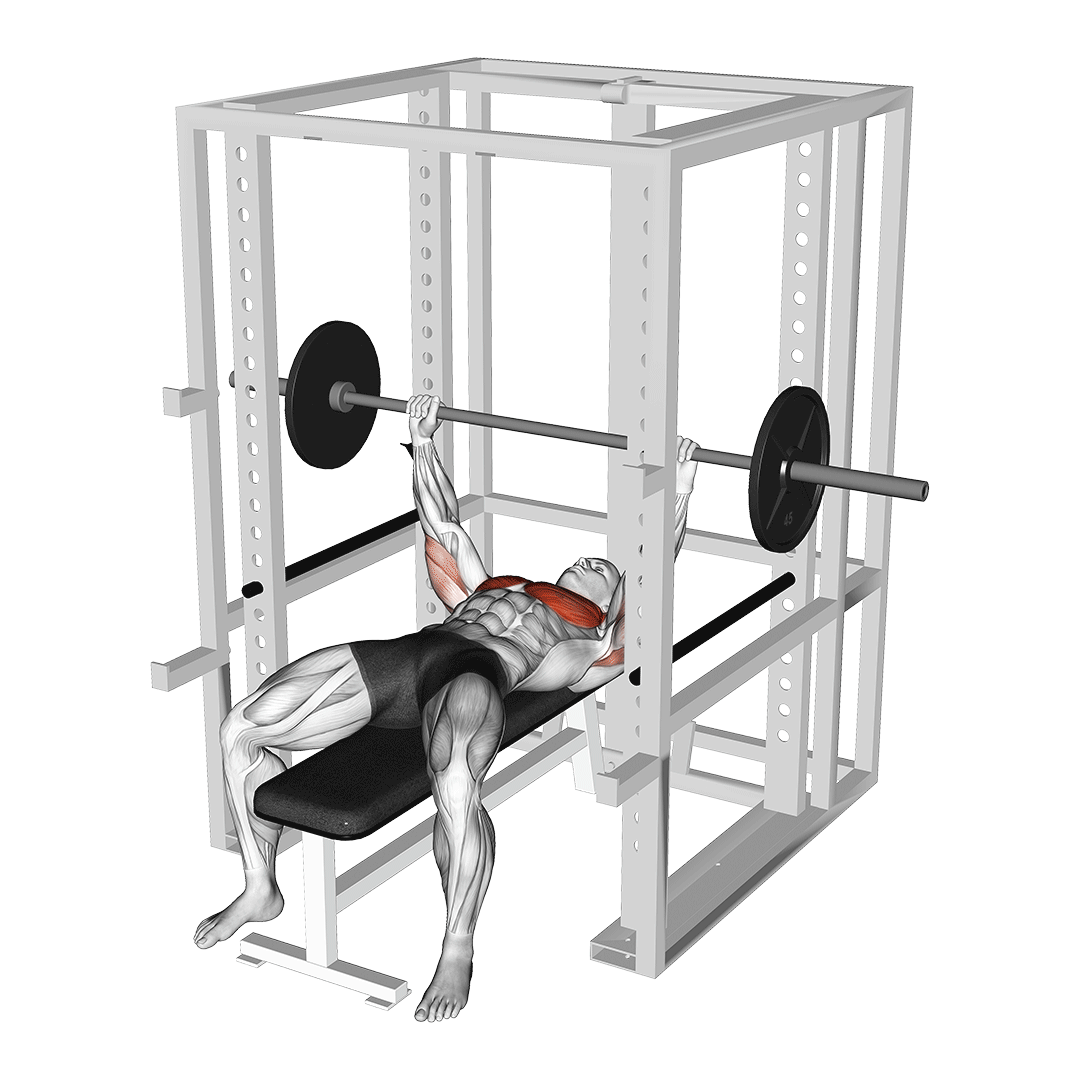
Rather than placing boards atop the lifter’s chest, the pin press makes use of a barbell rack’s safety pins to stop the bar in the upper half of the bench press range of motion. This creates greater emphasis on the triceps and helps correct issues near the lockout portion of the bench press.
Floor Press
The floor press is yet another bench press alternative that features a reduced range of motion.

Unlike the pin press or block press, the floor press is quite literally performed with the lifter lying atop the floor. This causes their elbows to be stopped by the ground as they complete the first half of their range of motion, creating similar benefits to the two aforementioned exercises.
Banded Bench Press
For a more functional substitute to the board bench press, lifters can perform a conventional bench press with bands tied to the bar and beneath the body.
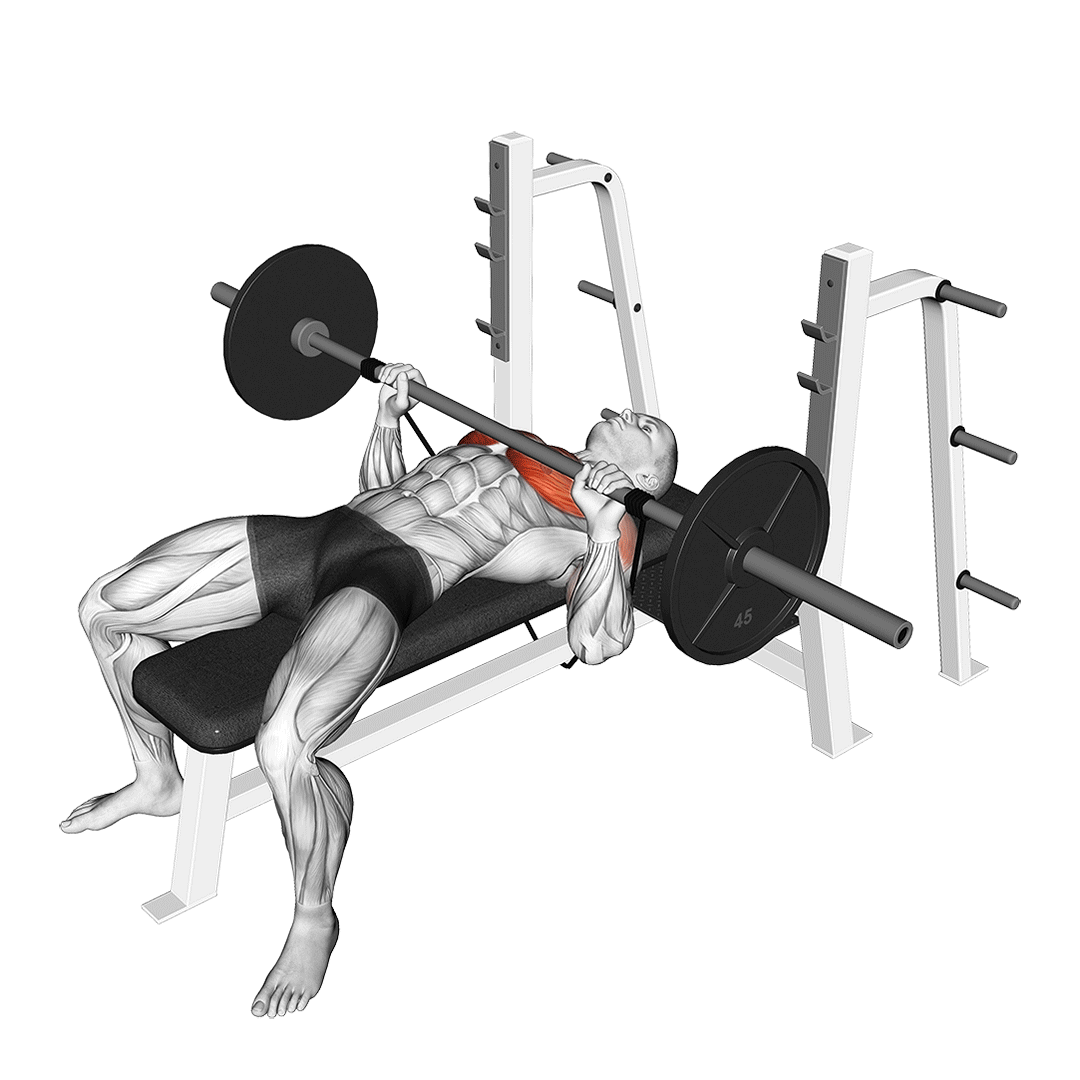
This creates a more difficult movement the further the bar is from the torso, leading to greater contraction of the triceps and deltoids and similarly correcting issues in technique. Of course, this is all without the same disadvantages associated with the board or pin press, as a full range of motion is still achieved.
Frequently Asked Questions (FAQ)
Why do People Bench Press With a Board?
More advanced weightlifters will often perform the barbell bench press with a board so as to correct a specific issue in their execution of the exercise. This can be a weak set of muscles, a problem in how they actually do the exercise or simply to acclimatize themselves to heavy weight.
Is the Board Bench Press Harder?
Not at all. The board bench press is considerably easier on the body as the range of motion is far shorter than with the regular bench press. This allows for more weight to be lifted for more repetitions.
How Thick is a 3 Board Bench Press?
Though it will depend on the specific brand (or if you’re using branded equipment at all), a 3-board is somewhere between 5-6 inches in thickness. This is enough to effectively cut most lifter’s range of motion in half.
In Conclusion
The board bench press is as effective a training tool as it is situational to use. Remember to ensure that you actually need it prior to including it into your technique-work session.
If you don’t have access to boards or a partner to hold them in place, the pin press or floor press can provide a safer and more convenient alternative - so long as the specific stopping point is the same.
References
1. Austin, Dan., Mann, Bryan. Powerlifting: The Complete Guide to Technique, Training, and Competition. United States: Human Kinetics, 2021. ISBN: 9781492598794, 1492598798
2. Kompf J, Arandjelović O. Understanding and Overcoming the Sticking Point in Resistance Exercise. Sports Med. 2016 Jun;46(6):751-62. doi: 10.1007/s40279-015-0460-2. PMID: 26758462; PMCID: PMC4887540.
3. Joseph P. Carzoli, Colby A. Sousa, Daniel J. Belcher, Eric R. Helms, Andy V. Khamoui, Michael Whitehurst & Michael C. Zourdos (2019) The effects of eccentric phase duration on concentric outcomes in the back squat and bench press in well-trained males, Journal of Sports Sciences, 37:23, 2676-2684, DOI: 10.1080/02640414.2019.1655131

